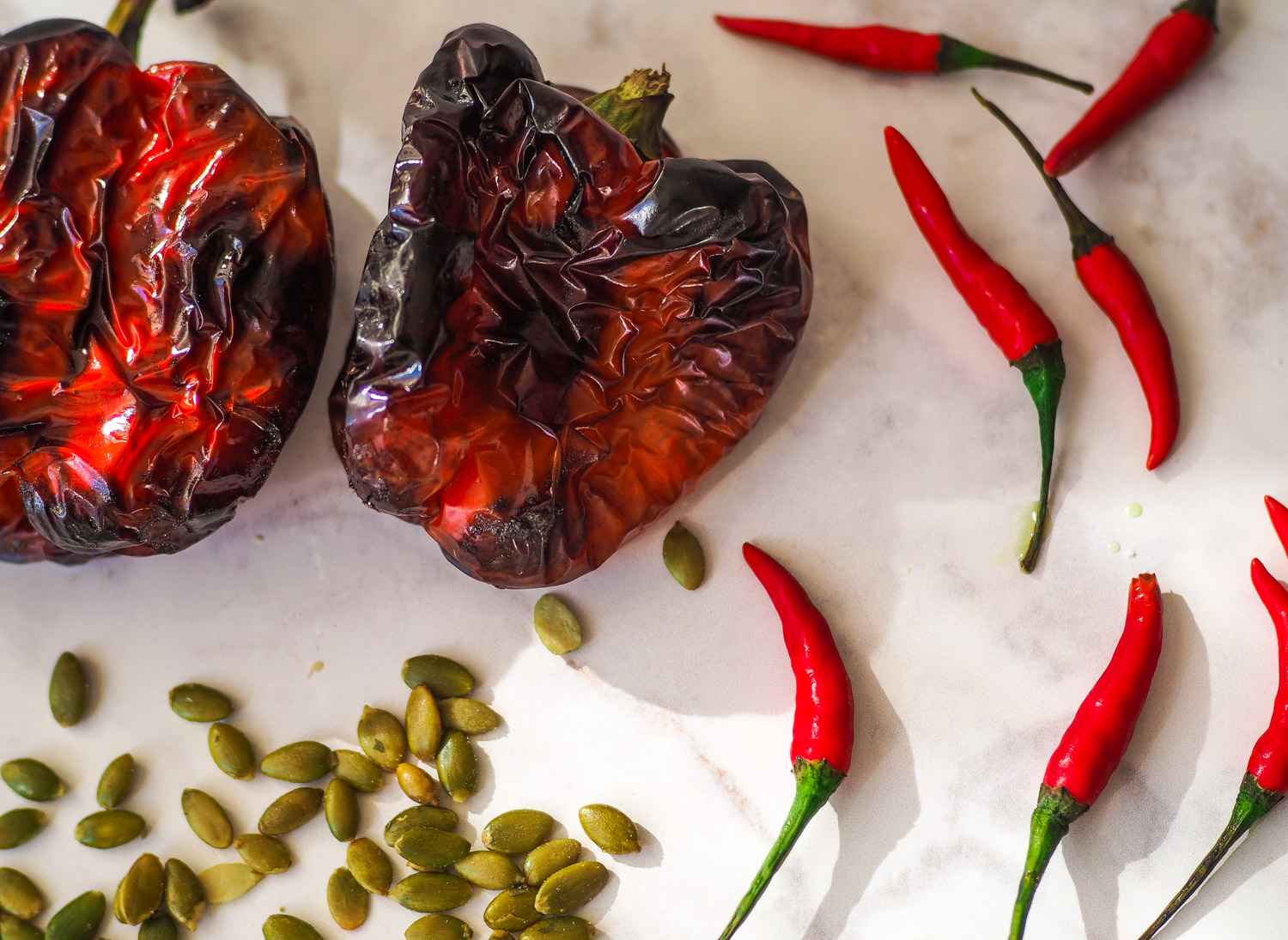Roasted Red Pepper Pesto Pasta

Perhaps it’s just the Mexican half of me talking (loudly and with wild hand movements peppered throughout), but roasting and peeling peppers has got to be one of the absolute most satisfying things to do in the whole world. Blackening peppers until they’re deeply burnt and blistered then letting them crumple in their own steam until the skins practically peel themselves off? Uffff, yes, give me more. Plus, it will never cease to amaze me how delicious certain vegetables taste when you essentially incinerate them and then slip off their filmy skins to reveal the sweetest, smokiest insides.
I love everything about this twist on traditional pesto, because it still contains the crucial elements – a good dose of herbs/greens, a salty cheese, nuts or seeds, garlic, and olive oil – while being as unlike traditional pesto as you can get. This pesto has a magnificently complex taste and any pasta lucky enough to cross paths with it emerges all earthy and nutty with an undercurrent of heat and acidity. It’s lovely. Like any good pesto, this one can take on other applications other than pasta sauce (I keep imagining it spread on a thick slab of crusty bread and eaten alongside something pickled). As with the traditional pesto recipe, this pasta is also best eaten right after its preparation.
Roasted Red Pepper Pesto Pasta
Adapted from J. Kenji Lopez-Alt (The Food Lab)
Serves 4
Ingredients:
2 large red peppers
1 ½ cups (1 oz) fresh flat-leaf parsley leaves, loosely packed
2 tbsp fresh oregano leaves
1 clove of garlic
3 tbsp crumbled feta cheese, preferably Macedonian-style or other creamier version + more for crumbling
1 small red Thai chile (or 2 if you like it hotter)
¾ cup roasted pumpkin seeds (pepitas), salted or unsalted
½ cup extra-virgin olive oil + more for drizzling
Juice from 1 small lemon
1 lb bucatini or spaghetti
Directions:
Preheat the broiler and set an oven rack to the second highest level. Place the red peppers on a foil-lined baking sheet and set under the broiler for 20 minutes. Turn the peppers over when time’s up and broil for another 10 minutes. Turn the peppers so that any remaining pale bits get exposed to the broiler and cook for another 5 minutes. The peppers should be super soft with blackened, blistered skins. Place the peppers in a small bowl, cover with plastic wrap, and set aside for 10-15 minutes. Once the peppers are done steaming, carefully pull the stems out (hopefully taking most of the core with you) and peel off the skins. Open up the peppers so that they’re flat and scrape out any remaining seeds. Set on a plate to cool.
Bring a large pot of lightly salted water to a boil. Set a colander inside a large bowl of ice water and set aside. Once the water is boiling, dunk the parsley, oregano, and garlic clove in the water for about 30 seconds, then use a slotted spoon or sieve to scoop them out and place them in the colander/water-bath. This is called blanching and it keeps the colour of the pesto vibrant over time.
Drain the garlic and herbs by removing them from the water and squeezing the leaves out with your hands. Transfer to a layer of paper towels and wring them out one more time, getting as much water out as possible. You will be left with a fraction of the herbs that you started out with.
Place the blanched parsley, oregano, and garlic in the bowl of a food processor along with the cooled peppers, feta, chile, pumpkin seeds, and olive oil. Pulse until smooth then scrape down the sides of the food processor and process for 30 more seconds. Transfer the pesto to a small bowl and stir in the lemon juice. Season to taste with salt and pepper.
Set a large pot of well-salted water to boil over high heat (this means you need to add more salt than you probably feel comfortable with – just do it – this is the only point where you really get to season the pasta itself). Cook the bucatini/spaghetti, stirring occasionally until the noodles are al dente (check the cooking instructions on the package). Right before the pasta finishes cooking, scoop out a cupful of the starchy water and set aside. In a large bowl, stir together ¼ cup pasta-cooking water with ½ cup pesto. Drain the pasta and immediately transfer it into the bowl with the pesto mixture. Use tongs to vigourously toss the pasta, drizzling a touch of olive oil over the noodles to help coat them evenly with the pesto. Keep tossing and add more pesto until the noodles are dressed and seasoned to your liking. Taste and season with salt and pepper as needed. Divide among bowls or a large serving platter and scatter extra feta cheese over top. Congratulate yourself on making such edgy hipster pesto.




